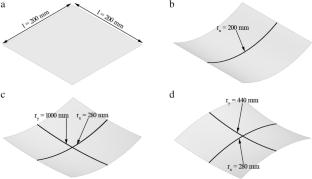Multi-point forming with individually controlled force–displacement (MPF-ICFD) is a novel multi-point forming process with characteristics of good deformation uniformity and high forming accuracy. The process has two different deformation sequences: positive forming (PF) and negative forming (NF). The shape accuracy of a part is significantly different when the deformation order is changed. To reveal the influence mechanism of the deformation sequence on shape accuracy, experiments and numerical simulations are used to assess shape accuracy during multi-point forming. The deformation behaviours of a cylindrical surface, sail surface and saddle surface in PF and NF processes are investigated to obtain the shape accuracy characteristics of a sheet under different deformation sequences. In addition, the strain distribution characteristics of the cylindrical surface are given quantitatively. The influence mechanism of the deformation sequence on the shape accuracy is revealed. The results show that the amount of plastic deformation on the part is significantly increased and the shape accuracy is significantly improved during the PF process. When the loading conditions are identical, the maximum strain of the cylindrical parts is increased by 73.4%, and the amount of springback is decreased by 90.0%. The above research indicates that the PF process has good application prospects in sheet metal forming.



